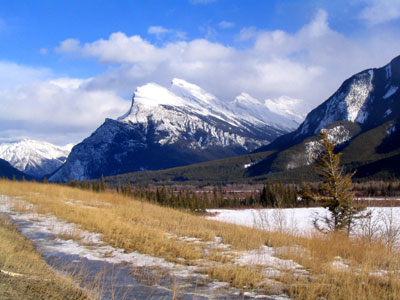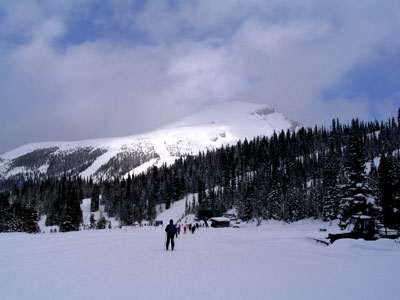The springs were discovered in 1894 and contain steaming water loaded with minerals. Even in the winter people sit in the open-air pool and enjoy the medicinal waters of the Upper Hot Springs. The fully restored bathhouse dates back to the 1930s and also provides day spa facilities offering massage therapy, a steam room, aromatherapy and other facilities. A restaurant and snack bar are also located in the Bathhouse.

The Banff Upper Hot Springs have been in operation since 1886
For a minute I was tempted to try the Hot Springs myself, but I didn’t have a bathing suit with me. Although the retail shop in the Bathhouse sells bathing suits I decided that rather than relaxing in the hot water I’d get a bit more exercise and I started my walk towards town.

Outside bathing in the hot springs in the middle of winter
Instead of taking the main road back to town I took a forest path that connects the Banff Upper Hot Springs with the Fairmont Banff Springs Hotel. It was a beautiful peaceful walk through the trees and it would have been perfect if I hadn’t been wearing the world’s most slippery boots. I had to watch every step on the sloping forest terrain to make sure I didn’t wipe out, and I finally arrived at the bottom of the hill, relieved to be back on a paved parking lot right next to the Banff Springs Hotel.

Coming out of the forest onto safe terrain
I strolled by this famous Banff landmark into town and crossed the road to explore the grounds of Canada Place, the home of the Banff Park administration since 1936. During the summer Canada Place offers free admission to an exhibit that celebrates Canada’s land, culture and achievements.

Canada Place
During the winter the facility is closed, but the view from the surrounding Cascade Gardens towards Cascade Mountain is stunning on a clear day. I wasn’t so lucky, for our entire week in Banff we never got to see famous Cascade Mountain completely clear and free of clouds. But never mind, the glimpses that we did catch gave us a feeling for this amazingly photogenic natural feature that is always pictured on Banff postcards.

View towards Cascade Mountain from Canada Place
From Canada Place I crossed the bridge over the Bow River and I visited another important landmark: the Banff Park Museum. It is one of Canada’s oldest and grandest natural history museum, housed in a historic “railway pagoda”, built in 1903, the largest and most elaborate example of early park design, using decorative cross-log construction.

The “railway pagoda” of the Banff Park Museum
Specimens inside the museum include mountain goats, deer, cougars, bisons, bears, a large variety of birds and mammals and some of these specimens date back to the 1860s. Norman Sanson, the weatherman on Sanson’s Peak, was the curator of this museum for over 30 years, and personally collected thousands of specimens for this museum.

Historic specimens in the Banff Park Museum
The museum also holds a library where you can browse through a variety of books and magazines. After I had informed myself about Western Canada’s wildlife I strolled down Banff’s main street, aptly named Banff Avenue, I strengthened myself with a quick late lunch in the food court at the Cascade Plaza Shops, one of Banff’s main shopping plazas. After lunch I headed back out on the street and a very chilly mountain wind had started blowing. This was my last walk through Banff on this vacation and I was mentally saying goodbye to this picturesque mountain town.

The Presbyterian Church on Banff Avenue

The famous Fairmont Banff Springs Hotel




